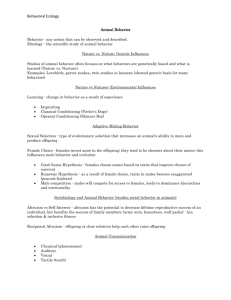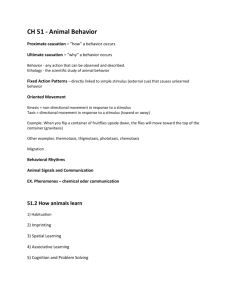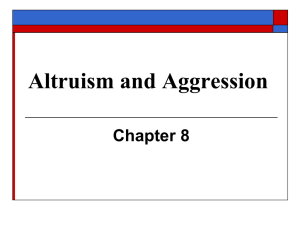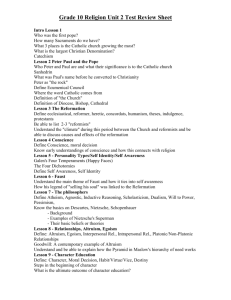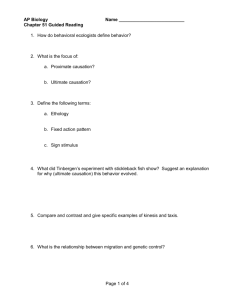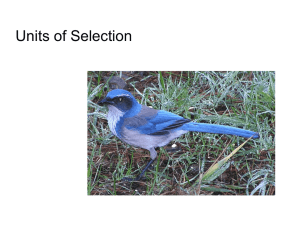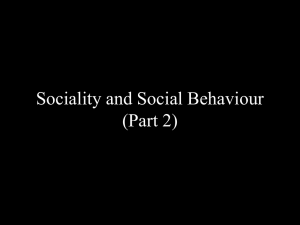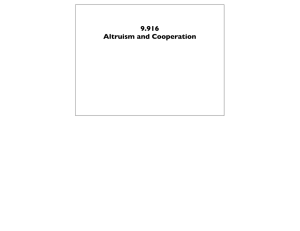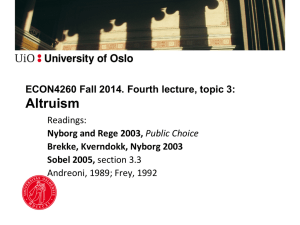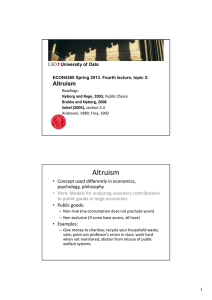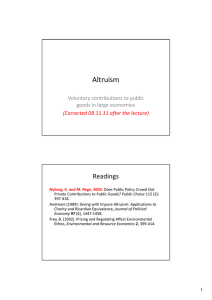Prosocial Slides
advertisement
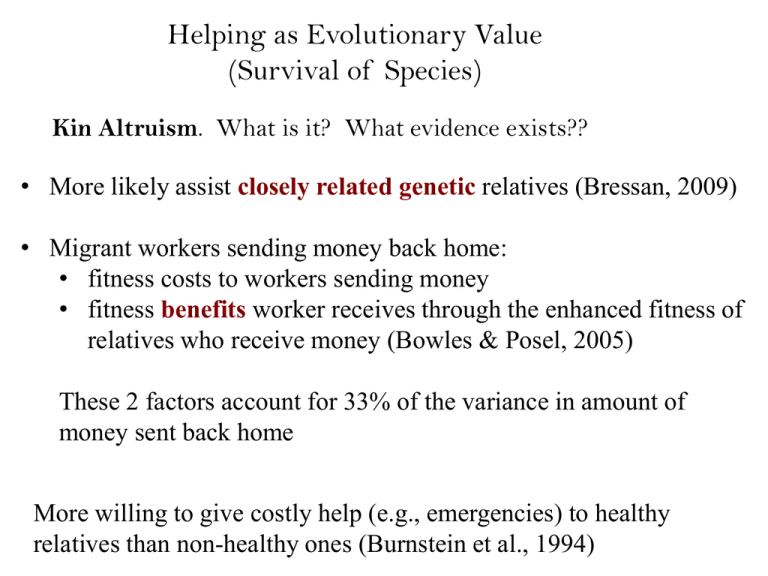
Helping as Evolutionary Value (Survival of Species) Kin Altruism. What is it? What evidence exists?? • More likely assist closely related genetic relatives (Bressan, 2009) • Migrant workers sending money back home: • fitness costs to workers sending money • fitness benefits worker receives through the enhanced fitness of relatives who receive money (Bowles & Posel, 2005) These 2 factors account for 33% of the variance in amount of money sent back home More willing to give costly help (e.g., emergencies) to healthy relatives than non-healthy ones (Burnstein et al., 1994) Direct Reciprocity/Reciporcal Altruism [Likely to get help in return for helping] Tit-for-Tat Strategy (e.g., respond based on the actions of others – most effective strategy across time): Cooperation = Cooperation Competition = Competition Advantages: •Begins “nice” – cooperation •Retaliatory •Forgiving (Competition then return to cooperation = Cooperation) • Straightforward/Clear ~ Kitty Genovese Story ~ (From New York Times, March 27th, 1964) For more than half an hour 38 respectable, law-abiding citizens in Queens watched a killer stalk and stab a woman in three separate attacks in Kew Gardens. Twice the sound of their voices and the sudden glow of their bedroom lights interrupted him and frightened him off, Each time he returned, sought her out and stabbed her again. Not one person telephoned the police during the assault; one witness called after the woman was dead. That was two weeks ago today. But Assistant Chief Inspector Frederick M. Lussen, in charge of the borough’s detectives and a veteran of 25 years of homicide investigations, is still shocked. He can give a matter-of-fact recitation of many murders. But the Kew Gardens slaying baffles him — not because it is a murder, but because the ‘good people’ failed to call the police. ‘As we have reconstructed the crime,’ he said, ‘the assailant had three chances to kill this woman during a 35-minute period. He returned twice to complete the job. If we had been called when he first attacked, the woman might not be dead now.’ Basic Assumption Groups should be more likely to help in emergency situations But what if the situation is relatively ambiguous (as most emergencies may be, or at least start off, in such a manner)? Presence of others as a source of information (social cues) Latane and Darley’s Model of Emergency Intervention (1970) Notice the Event? Define as Emergency? Take Responsibility? Have the qualifications to help? Decide to Help? HELP Smoke-Filled Room Study Procedure? Did the presence of others affect how quickly participants noticed the smoke in the room? Alone = Less than 5 seconds (63% noticed within 5 sec.) Group = About 20 seconds (26% noticed within 5 sec.) What if a condition existed where a confederate signaled the need to help? Epileptic Seizure Study Procedure? You are driving along a city street and you notice that a car has slid across the shoulder and into a ditch. A middle-aged woman is standing next to the car, bewildered. You are running a a few minutes late to meet to meet someone in town, but it’s obvious that the woman needs help. What would you do? % helping Time Pressure and Helping 60 50 40 30 20 10 0 Ahead of schedule On schedule Behind schedule In a local grocery store you notice a small child in a shopping cart. A woman, likely the mother, slaps him in the face and yells for the child to shut up or be hit again. You fell bad for the child but you wonder if you’d make things worse if you say something. What would you do? Perceived Costs & Helping Blood on Victim Strangers Arguing No Blood on Victim Couples Arguing Who gets the most help in each case above? Piliavin and Piliavin’s Cost Analysis of Emergency Intervention How do perceived costs for helping and not helping affect our willingness to intervene in an emergency? Low High Low Costs (to victim) if No Direct Help Given Costs (to helper) for Directly Helping Victim Direct Intervention Intervention or nonintervention largely a function of perceived norms in situation High Indirect intervention or Redefinition of the situation, disparagement of victim, etc., which lowers costs for no help, allowing Leaving the scene, ignoring, denial You a watching the TV news about a large-scale national disaster across the world. Men, women and children are shown blankly starring at the TV screen. It’s easy to contribute; you can donate money by calling a number on your cell phone. How would this make you feel? What would you do? Impact of Past Experience on Helping Thanked for helping Ask for directions Give help What are the “big picture” implications of such a finding, especially for long-term helping efforts? “Punished” for helping (“I cannot understand what you’re saying. Never mind, I’ll ask someone else” Less likely to provide assistance in future The United Nations Special Envoy to Haiti has reported that only 40 percent of money raised for Haiti in 2010 has been distributed, and only 15 percent of needed temporary housing has been built. From: The Oakland Press, Wednesday, January 26, 2011 Rank 1 2 3 4 5 6 7 8 9 10 Charity Disabled Veterans Associations Children's Charitable Foundation Firefighters Charitable Foundation Disabled Police Officers Center Law Enforcement Education Prog. Operation Lookout Wishing Well Foundation USA Children's Charity Fund, Inc. Coalition Against Breast Cancer Children With Hairloss Expenses 4.6% 10.3% 8.3% 11.8% 2.2% 2.6% 10.3% 5.7% 18.3% 24.5% Fundraising 94.3% 87.3% 86.4% 85.7% 84.1% 80.8% 78.3% 78.1% 78.1% 72.3% ~ Gender and Helping ~ • Overall, males provide more help than females (e.g., emergency interventions, giving $ to strangers, helping individuals who have dropped an item). Also, males give more money when female observer is present (Signaling Theory – communicate information to others about giver’s qualities)) BUT: • Females provide more emotional help than males (e.g., social support, caregiving) • Females: • 13% more likely to donate kidneys • 16% more likely to serve in Peace Corps • 2 times greater chance of serving as physicians with Doctors of the World Who Receives Help? • Females (meta-analysis: 1.69 standard deviations more help for females) • Similar and familiar others • Attractive individuals Similarity Wrong phone number study Heterosexual making request 100 Homosexual making request 90 80 90 70 70 60 50 40 30 30 35 20 10 0 Male From Shaw, Borough, & Fink, 1994 Female Moods (e.g., Guilt) on Helping [Negative State Relief Model] Break camera Versus Camera malfunctions Helping? Before confession Versus After confession Attributions & Helping External attribution (e.g., poor economy is at fault) Helping request (e.g., stranger asking for spare change) Physiological arousal What are the “big picture” implications of such a finding, especially for social programs (e.g., unemployment insurance, health care, food stamps)? Positive emotions Helping Analysis of the situation Internal attribution (e.g., stranger is lazy) Negative emotions No helping Personality Characteristics of People Choosing to Help [Assistance to driver after a traffic accident] • High empathy scores • Strong belief in a just world (“people get what they deserve”) (Other research: greater helping when people believe others deserve help but less helping when other’s problems are perceived as selfinflicted) • Greater levels of social responsibility • Internal locus of control scores • Less egocentric (selfish) Sample Altruism Items • I have given directions to a stranger. • I have given money to a charity. • I have donated blood. • I have delayed an elevator and held the door open for a stranger. • I have allowed someone to go ahead of me in a lineup (at Xerox machine, in the supermarket). • l have pointed out a clerk's error (in a bank, at the supermarket) in undercharging me for an item. • I have helped a classmate who 1 did not know that well with a homework assignment when my knowledge was greater than his or hers. • I have voluntarily looked after a neighbor's pets or children without being paid for it. • I have helped an acquaintance to move households. --- From Rushton, Chrisjohn, & Cynthiafekken Sample Locus of Control Items Do you believe that most problems will solve themselves if you just don't fool with them? Do you feel that you have a lot of choice in deciding who your friends are? Most of the time, do you feel that you can change what might happen tomorrow by what you do today? Do you think that people can get their own way if they just keep trying? Are some people just born lucky? Do you believe that if somebody studies hard enough he or she can pass any subject? Are you often blamed for things that just aren't your fault? Sample Just World items • I am confident that justice always prevails over injustice. • I think basically the world is a just place • I am convinced that, in the long run, people will be compensated for injustices. • I firmly believe that injustices in all areas of life (e.g. professional, family, politics) are the exception rather than the rule. • I believe that, by and large, people get what they deserve • I think that people try to be fair when making important decisions. (From: Dalbert, Montada, & Schmitt, 1987) Does Altruism Exist? “Kindness is it’s own reward.” Egoism: Behaving in one’s own self interest Altruism: Unselfish concern for others • Helping is a behavior • Egoism and altruism are motivational forces How can we know? One assumption: If altruism exists, the level of costs involved should not impact the behavior of those helping out

